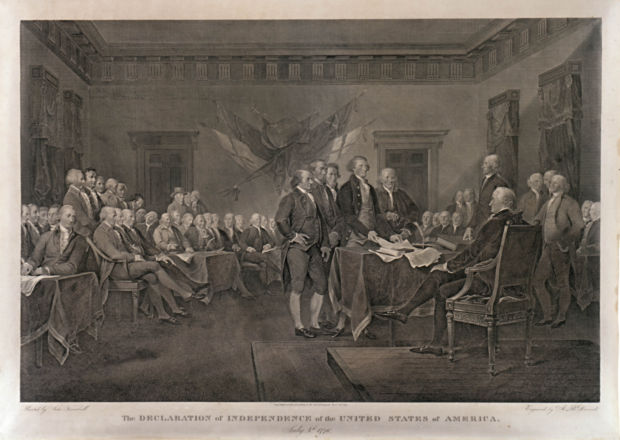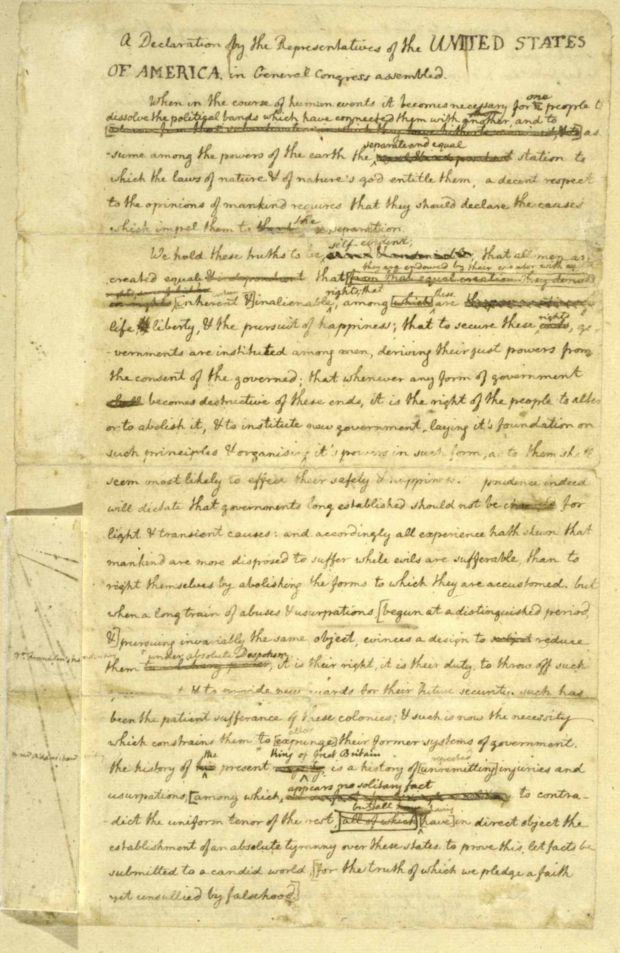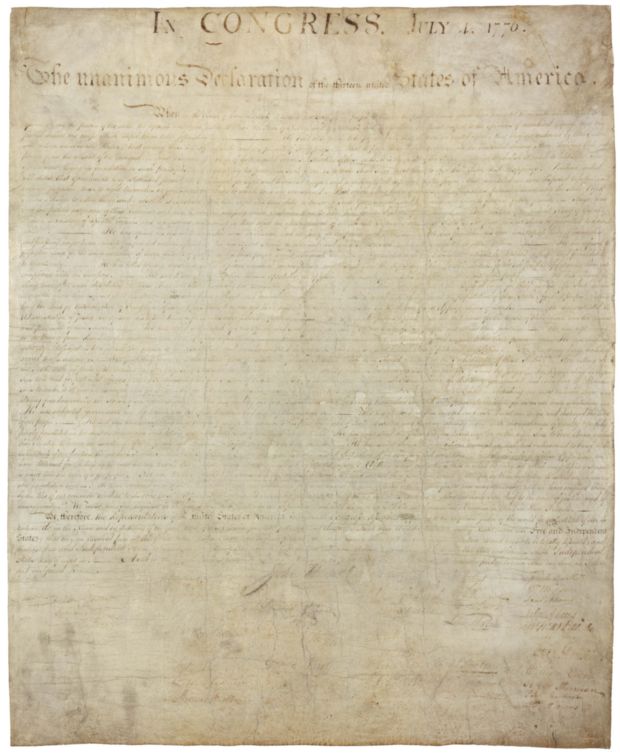Jefferson and the Declaration of Independence
Reading Level: Middle School
In early May, 1776, Jefferson made a week-long journey to Philadelphia to be a delegate to the Second Continental Congress. At thirty-three years old, he was the youngest member of the Congress.

Engraving of the painting “The Declaration of Independence” by John Trumbull depicting the Committee of Five presenting the Declaration to the Second Continental Congress.
The Committee of Five
Congress appointed a committee of five to draw up a statement explaining why the colonies wanted independence. They chose John Adams of Massachusetts, Roger Sherman of Connecticut, Benjamin Franklin of Pennsylvania, Robert Livingston of New York and Thomas Jefferson of Virginia.
Jefferson was thirty-three years old, one of the youngest members of Congress. He was not a fiery speaker. John Adams said of Jefferson, “During the whole time I sat with him in Congress, I never heard him utter three sentences together.” But he was known for his skill as a writer. The committee chose Jefferson to draft the declaration. Jefferson, however, wanted Adams to be the actual author. Adams reportedly replied, “You can write ten times better than I can.”

Jefferson’s Rough Draft of the Declaration of Independence.
Drafting the Declaration of Independence
The committee of five met several times to talk about ideas and organization. Thomas Jefferson then set out to draft a declaration. He worked for two and a half weeks in the parlor of his rented rooms. He’d rise before dawn and have tea and biscuits. Quill pen in hand, he’d sit down at his “plain, neat, convenient” writing desk that he had designed. He ripped up early drafts. Only a small piece of an early draft remains, showing he changed nearly one third of his words.
“I see my job as trying to bring together and harmonize a variety of different opinions,” Jefferson wrote. “We are putting before all of mankind words that are both simple and firm, a justification for the stand that we’re being forced to take.”
Influences on Jeffersons Writing
Thomas Jefferson used no books or pamphlets to help him write the Declaration of Independence. But since his early days, he’d thought and read about government and the rights of mankind. He read British writer John Locke, who believed that people are born with natural rights. Governments should be for the benefit of everyone, not just the rulers. (These ideas were evident in Jefferson’s ideas for Virginia’s new state constitution.) Thomas Paine had also expressed a similar idea in Common Sense: “A government of our own is a natural right.”
Jefferson’s draft was also influenced by George Mason, a plantation owner in Virginia. Mason wrote a phrase similar to “pursuit of happiness” in his draft of “Virginia’s Declaration of Rights.” Jefferson was probably influenced by Dr. William Small of Scotland as well. Small had taught Jefferson for four years at the College of William and Mary. Jefferson described his professor as a man with “an enlarged and liberal mind.”
“I did not consider it a part of my charge to invent new ideas,” Thomas Jefferson later wrote about writing the Declaration, “but to place before mankind the common sense of the subject.”
All Men are Created Equal
In the declaration, Jefferson linked many of these ideas. In the first part of the Declaration (called the preamble) he wrote that all men have rights including “Life, Liberty and the pursuit of Happiness.” He wrote that the colonies were no longer bound to England. Governments should get their power from the people, not a king.
In another section, Jefferson listed the many ways that King George III had neglected his duties to the people. These included “imposing taxes on us without our Consent” and “cutting off our Trade with all parts of the world.”
Jefferson also drafted a section attacking the slave trade. He described slavery as “a cruel war against human nature itself, violating its most sacred rights of life and liberty.”
The final draft was shown to Franklin and Adams. They made a few small changes before giving it to Congress on June 28th, 1776. However, delegates from South Carolina and Georgia would not sign it because of the language against slavery. There were also delegates from New England who would not sign because their merchants had profited from the slave trade. Congress debated the issue, and all language about slavery was taken out.

Original copy of the Declaration of Independence at the National Archives in Washington, DC. Image courtesy the National Archive and Records Administration
Independence!
From late Tuesday July 2 through Thursday July 4th, Congress made changes in Jefferson’s draft of the Declaration. Jefferson’s text was cut by about a fourth. Congress also included the words of Lee’s Resolution “That these United Colonies are, and of Right ought to be Free and Independent States.” On July 4th delegates from twelve colonies voted for the written declaration.
That day, in the late afternoon, Congress approved the written Declaration of Independence. John Hancock, president of Congress, signed it, making the document “legal and binding.”
The first public reading of the Declaration of Independence was in Philadelphia on July 8th . The crowd cheered; church bells rang. By July 15th, all thirteen states had agreed to the resolutions in the new declaration.
The Declaration was written on parchment made from animal skin. On August 2nd, it was signed by the members of Congress, including Thomas Jefferson.

Engraving of the Declaration of Independence. Image courtesy the National Archive and Records Administration
Impact of the Declaration of Independence
The Declaration of Independence is a famous document for many reasons. It declared the colonies independence from Great Britain. It stated basic rights and liberties for Americans. The French used the ideals behind the Declaration as a model for their own revolution in 1789.
As time went by, the ideals behind “all men are created equal” grew in importance. Northern states used them to free slaves in their states. Abraham Lincoln used equal rights to justify the war against slavery. In 1963, Martin Luther King, Jr. stood on the steps of the Lincoln Memorial in Washington, D.C.. In his famous speech he repeated the ideals of the Declaration “that all men are created equal.”
Women used equal rights to fight for the vote. In 1848, women at an equal rights meeting in New York wrote that “all men and women are created equal.”

